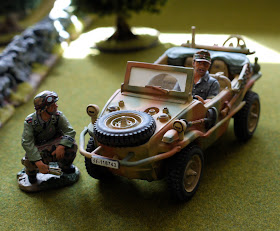This model wasn't originally on my wish list but a couple of months ago the company announced its retirement, reported on in a previous post, and I decided to buy it, primarily, if I'm honest, for the sheer novelty value. It's a quirky little piece, and makes a more than welcome addition to any 'break in the fighting', 'down time', or 'back at base camp', type diorama
Painted in a summer camo pattern, this K+C version is marked up as a Waffen SS vehicle, part of the Liebstandarte division to be precise, and could be displayed equally well as part of a Normandy or an Eastern Front diorama
 |
| Even elite soldiers have to shit in a hole! |
Volkswagen (Porsche) Type 166 Schwimmwagen
Initially named the Type 128, the Type 166 Schwimmwagen, literally ‘swimming car’, was developed for the German Army by the Porsche company in 1940-'41 and used the engine and mechanicals of the VW Type 86 four-wheel drive prototype of the Kübelwagen and the Type 87 four-wheel drive 'Kübel/Beetle' Command Car, which in turn were both based on the platform of the civilian Volkswagen Beetle
Development began on July 1st, 1940, when the company was given an order to design an amphibious vehicle. Less than a week later work on the model 128 was under way and the first prototype was ready by September. The Army received their first three prototypes on November 1st 1940, and undertook extensive testing which lasted until December 6th. From May through to August 1941 further tests by other departments were conducted. All in all they were positive. In February 1942 the Porsche company proposed building 3 different cars: a long type 128, a long type 138 and a short type 166. At the end of April 1942, after being selected as the only type to be mass-produced, the specifications for the type 166 were determined. The German Army ("Wehrmacht") approved this model at the end of May 1942 and by June 6th the first 100 cars, produced in Wolfsburg, were ready
Early designs had a housing for the propeller, which was later discarded, leaving it exposed at all times. The propeller was steerable, which was another feature later discarded. The type 128 was also longer and wider than the type 166, having a wheel base of 240 cm, and fitted with custom welded bodytubs. Testing demonstrated that this construction was too weak for tough off-roading, had insufficient torsional rigidity, and easily suffered hull-ruptures at the front cross-member, as well as in the wheel-wells. The large-scale production models (Type 166) were therefore made smaller, and had a wheel-base of only 200 cm (6.6 ft)
When crossing water a screw propeller could be lowered down from the rear deck engine cover. When in place a simple coupling provided drive straight from an extension of the engine's crankshaft. This meant that screw propulsion was only available going forward. For reversing in the water there was the choice of using the standard equipment paddle or running the land drive in reverse, allowing the wheel-rotation to slowly take the vehicle back. The front wheels doubled up as rudders, so steering was done with the steering wheel both on land and on water
The approved version of the vehicle was mass-produced at Wolfsburg, where the Volkswagen factory was located, and at Stuttgart, the home of Porsche, with the bodies/hulls being fabricated by Ambi Budd in Berlin. From 1941 through to 1944 a total of 15, 584 cars were produced; 14, 276 by VW at Fallersleben and 1, 308 by Porsche
Vital Statistics
Weight: 890 kg
Crew: 4 men
Engine: VW Boxer 1131cc / 4-cylinder / 25hp
Speed on road: 80km/h
Speed on water: 10km/h
Range on road: 520km
Fuel Capacity: 2 x 25 litres
Fuel Consumption: 9.5 litres/100km
Length: 3.825m
Width: 1.48m
Height: 1.615m (with the roof) 1.080m (w/o the roof)
Armament: none, or one 7.92mm MG34
Armor: none
Crew: 4 men
Engine: VW Boxer 1131cc / 4-cylinder / 25hp
Speed on road: 80km/h
Speed on water: 10km/h
Range on road: 520km
Fuel Capacity: 2 x 25 litres
Fuel Consumption: 9.5 litres/100km
Length: 3.825m
Width: 1.48m
Height: 1.615m (with the roof) 1.080m (w/o the roof)
Armament: none, or one 7.92mm MG34
Armor: none
 |
| 'Schwimmy' in the snow! Those Hummels in the background look menacing! |
 |
| SS Schwimmwagen |
 |
| The humble Schwimmwagen, with the not-so-humble Hermann! |
 | |
| Two shots taken at The War and Peace Show in 1998 |
For more information about this curious and loveable little vehicle, take a look at the following website which is dedicated to it. See you again soon












No comments:
Post a Comment